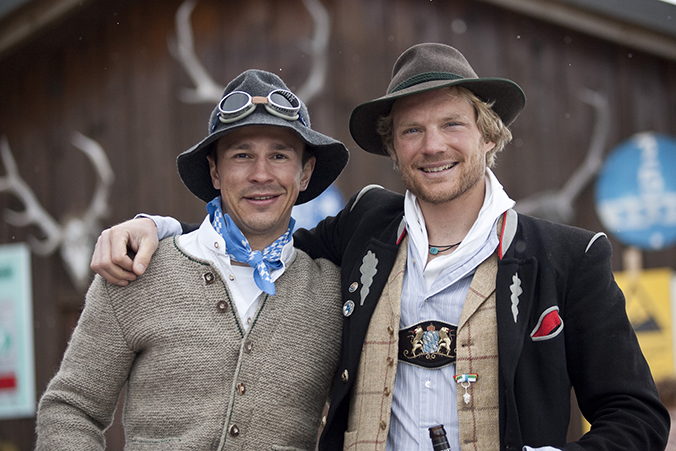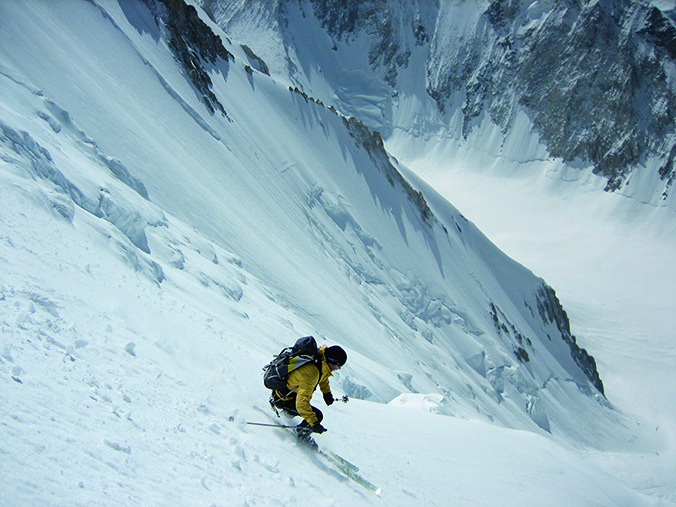Bene Böhm: I’m married with a son, with a second one coming in June. Definitely because skiing is my passion, and there’s not much else, of course I want to give them a view into that world. But I also know that it’s very dangerous, and I don’t want to pressure them. I’ll put them on skis, and when they still like it, I’ll keep taking them. The most important thing for me is that they find a passion, no matter what it is. If it’s a musical instrument, as long as they have something that they feel, I’ll be happy. I have five siblings, so I know that talents are so different. I’m the only skier, and we have two doctors, an artist and a geologist in the family. My kids very well might say, “Hey dad, skiing sucks,” and then it’s OK.
I grew up cross-country skiing in Munich. We had a hut not far from there, and that’s where I was first introduced to the mountains. When I was 18, I finished high school and had to join the army. It was mandatory in Germany at the time. That was in the mid-’90s. So I did two months of basic service, and then traveled around doing these competitions for the rest of the time. That was the first time that I got into racing.
For those races, we had M16s and full military gear. We had to shoot up manikins and throw grenades for points. Then we had to build a rescue sled and put one soldier in and take them down as fast as possible. I was asked if I wanted to stay on after my service, but I felt like I was getting dull in the head. So I only did that for 10 months.
Most of the best European racers today are in the army. Being in the army is how they fund their athletic careers. They can train all day, they get doctors, everything. These events still exist today, especially in Italy and Germany. During the top competitions, there were 32 armies represented, even from Afghanistan.
After that I studied for three years in England, and I really started to miss the mountains. So I started training more and more, and I heard there were these ski mountaineering competitions, and right after my studies, I started in on them. This was also the first time I was introduced to the Dynafit bindings. Then I was chosen to be on the German national team, and traveled for competitions and so on.
After those years competing professionally, I realized that I wanted my whole life to be about the sport. So in 2003, I applied to work for Dynafit. When I started working for Dynafit in 2003, I remember them saying, “Hey, we really appreciate you competing on the national team, but winter is our main season and you’ll be traveling a lot, so we don’t think you’ll be able to keep it up.” They wanted me to be one of the main people for the company. But they told me to just go ski in the summer. In October of 2004, I came back to them and told them that I was going to Peru to ski Huascaran. So this was actually how I got into expedition skiing—because of my job constraints. Then my speed ascents started coming, and I got media coverage.
All this ski touring gear has become much more durable and lighter. It’s crazy. The first skis I was skiing on were already pretty light, and the industry standard just kept getting lighter. Bindings and boots, too. But none of that stuff was very reliable. Back then you had like 20 percent of racers not finishing because of broken gear, which just doesn’t happen anymore. Now we have to focus on durability, because the one time a ski breaks, it goes on Facebook and that’s it.
So even though it seems like we focus on the uphill, the race is still won or lost on the downhill. There are so many great uphill athletes. And they’re running up and around super exposed ridges and with tons of steep stuff. But you need very good skiing skills in order to be super fast in skimo.
I still compete in skimo races, but I’m not on the national team. I’d rather spend the day skiing somewhere where it’s really cool than getting in a car for two hours and waiting for the race to start and so-on.
This year I hope to go to Cho Oyu, or somewhere in the Himalaya. I try to go once a year, or once every two years to that region. My main partner is Basti Haag. He’s one of the best skiers I know, especially in the steeps and especially in his head. We grew up together, which is why we are such a good team. I was coming from the endurance side, he was pushing on the down, I was pushing on the up, and we were both benefiting each other.
We’ve learned a lot together. We experienced a lot of serious things, like on Manaslu, where 11 people died. But on expeditions before, we had people dying in our hands more or less. And, of course, you grow up. You get more mature and see more things, and it sounds strange, but you learn to read the mountain. Just like my little son—he doesn’t know that red means stop and green means go. But now he starts recognizing and seeing things, so he’s learning those instincts. Just like we did.
Our first expeditions, even though they were not so high, were the most dangerous because we were just going out there. And now its much more strategic. And absolutely, it’s about knowing your limits. I think we could have done much better on those early trips. I have to say, we were really stupid. We were so proud, but we almost killed ourselves. The following expeditions, we totally changed our mentality.I think that in life, no matter what you do, whether it’s your job or whatever, you learn from your mistakes. It’s not just like reading a book. There are two ways: learning through pain, or being more strategic.
For me, to get in the mountains, the whole action of movements and being lonely in the mountains—it’s the most stable thing in my life. I have a couple local mountains that I’m totally in love with, and I know exactly how they’re going to be. I have to be the first one to ski them in the morning. And I know they’ll always be there. Human beings might die, but those mountains will always be there.
Being by myself in the mountains is my biggest filter. Especially with work, where I’m managing all these people and these product lines and so on. It’s the only time I don’t have my cellphone, I don’t have my laptop. Around three or four hours out from the car, suddenly I start to get solutions and start to think about what we can do better as a company. I keep a notebook in my car, and I always write down two or three points when I get back, like simple things, but also very important things.
And in the end, I always come back with a smile on my face.
Annotated Ticklist:2012: Manaslu, Nepal (8,163 m/26,759 ft). Speed ascent followed by ski descent on Sept. 30. From base camp at 16,404 feet to the summit in 15 hours with Sebastian Haag and Constantin Pade.
2010: Karakorum, Pakistan. Ski expedition along the Baltoro Glacier with Pete Swenson and Javier Campos.
2009: Broad Peak, Pakistan (8,046 m/26,414 ft). Speed ascent followed by ski descent on July 17. From base camp (4,800 m/15,748 ft) to forepeak (8,026 m/26,345 ft) in 16 hours with Sebastian Haag.
2006: Gasherbrum II, Pakistan (8,035 m/26,362 ft). Speed ascent with ski descent on July 29, to the summit and back in 17 hours with Sebastian Haag.
2005: Mustagh Ata, China (7,546 m/24,757 feet). Benedikt Böhm, Sebastian Haag and Matthias Robel reached the summit and ski down successfully on Aug. 23, in 10 hours, 40 minutes.
2004: Cordillera Blanca, Peru. Non-stop ski from the summits to glacier’s-end of Nevado Chinchey (6,222m/20,413 ft), Nevado Copa Sur (6,188 m/20302 ft), Nevado Copa Norte (6,173 m/20,253 ft), Nevado Huascaran Sur (6,768 m/22,205 ft) with Sebastian Haag and Julian Würmser.



![Bene on Manaslu in 2012. [photo] Courtesy of Dynafit manaslu_exped_downhill_1](http://backcountrymagazine.com/wp-content/uploads/2014/01/manaslu_exped_downhill_1.jpg)









Hi,
I started a ski mountaineering program at Sugarbush in Vermont, USA. This is the 6th season. Younger and younger kids are interested but currently there are no at bindings that fit small boots. Maybe the dynafit boots go small enough. What us the smallest Dynafit size boot available? Is the industry doing anything equipment wise for kids?
Thanks,
Rick hale
The Smallest Dynafit Boot Available comes in a size 22.5–that’s typically the smallest size out there. –Tyler Cohen, Managing Editor
Like mister Hale’s comment above about tech equipment for kids, i too, am curious if this is a consideration?
My wife and I are very recreational ( read “occasional”)backcountry enthusiasts here in canada & We have been looking for equipment for our sons, but find choices poor or heavy.
Plenty of en piste choices but to find Bc bindings with a low enouGh din setting and small enough to accomodate a small boot is difficult.
We have had to use a xc skis on the up and change over to downhill for the descent which is cumbersome for adults and cold for the kids.
There must be some market for you guys with this group?
Cheers
Sandro
Hey Sandro and rick, have you considered modifying the kids boots by attaching a tech sole to them? Salomon/Atomic/Black Diamond all offer replacement sole kits, and with some good bootwork you could mod them on to the junior boots. Then they can at least use a Dynafit binding.
Great article–love the story